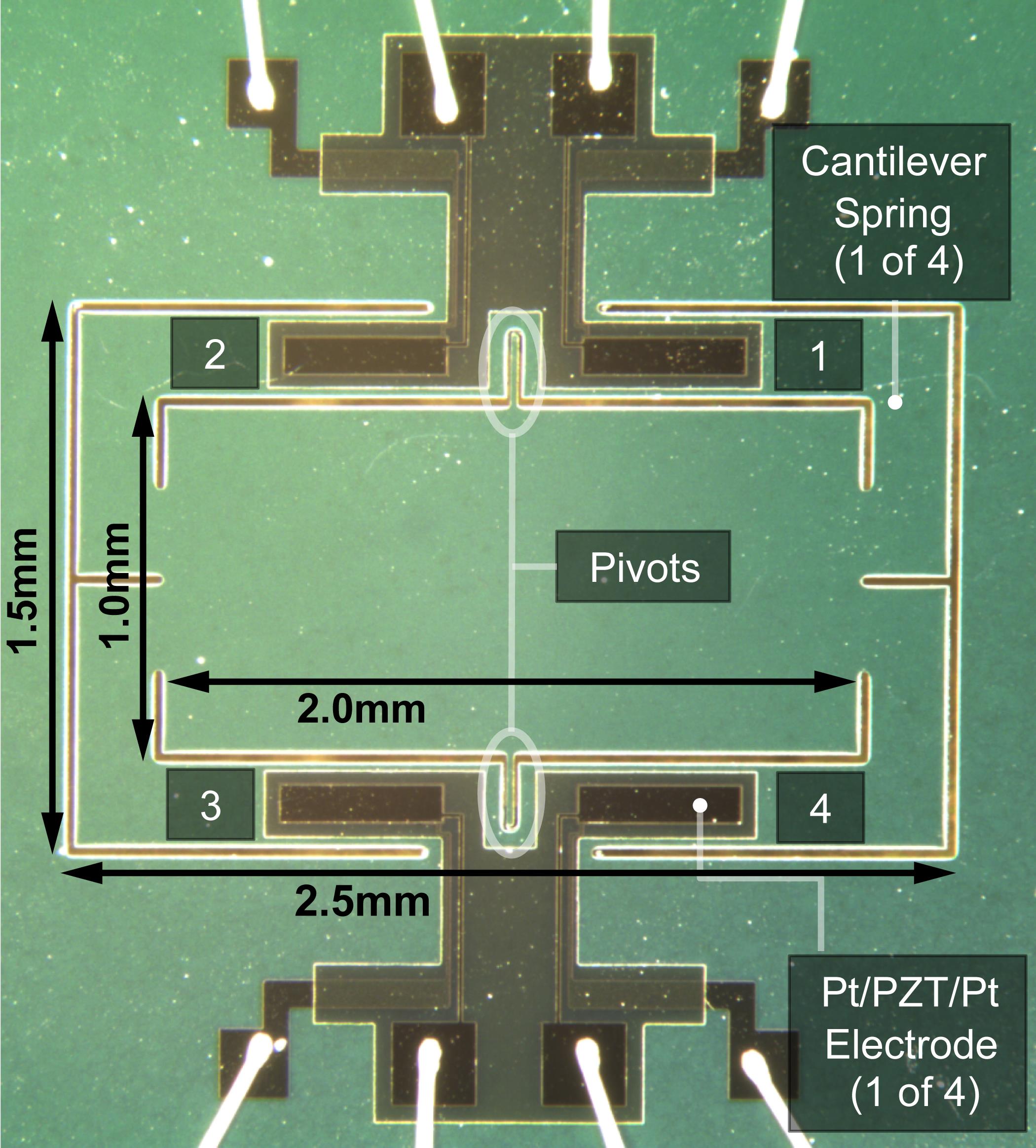A fly-inspired miniature microphone
July 25, 2014

This is a top-side view in a microscope photograph of the biologically inspired microphone. The tiny structure rotates and flaps about the pivots (labeled), producing a voltage across the electrodes (labeled). (Credit: N. Hall/UT Austin)
University of Texas Austin researchers have developed a tiny prototype microphone device that mimics the Ormia ochraceafly’s hearing mechanism. The design may be useful for a new generation of hypersensitive, millimeter-sized, low-power hearing aids.
The yellow-colored Ormia ochracea fly, the inspiration for the design, can pinpoint the location of a chirping cricket with remarkable accuracy because of its freakishly acute hearing, which relies upon a sophisticated sound processing mechanism that really sets it apart from all other known insects.
Described in the journal Applied Physics Letters, from AIP Publishing, the 2-millimeter-wide device uses piezoelectric materials, which turn mechanical strain (from sounds) into electric signals that can be used to stimulate sensors in the inner ear. The use of these materials means that the device requires very little power.
“Synthesizing the special mechanism with piezoelectric readout is a big step forward towards commercialization of the technology,” said Neal Hall, an assistant professor in the Cockrell School of Engineering at UT Austin. “Minimizing power consumption is always an important consideration in hearing-aid device technology.
There are military and defense applications as well, and Hall’s work was funded by the Defense Advanced Research Projects Agency (DARPA). In dark environments, for instance, where visual cues are not available, localizing events using sound may be critical.
Super Evolved Hearing
Humans and other mammals have the ability to pinpoint sound sources because of the finite speed of sound combined with the separation between our ears. The spacing of several centimeters or more creates a slight difference in the time it takes sound waves to hit our ears, which the brain processes perceptually so that we can always experience our settings in surround sound.
Insects generally lack this ability because their bodies are so small that sound waves essentially hit both sides simultaneously. Many insects do detect sound vibrations, but they may rely instead on visual or chemical sensing to find their way through the fights, flights and forages of daily life.
O. ochracea is a notable exception. It can locate the direction of a cricket’s chirp even though its ears are less than 2 mm apart — a separation so slight that the time of arrival difference between its ears is only about four millionths of a second (0.000004 sec).
But the fly has evolved an unusual physiological mechanism to make the most of that tiny difference in time. What happens is in the four millionths of a second between when the sound goes in one ear and when it goes in the other, the sound phase shifts slightly. The fly’s ear has a structure that resembles a tiny teeter-totter seesaw about 1.5 mm long.
Teeter-totters, by their very nature, vibrate such that opposing ends have 180-degree phase difference, so even very small phase differences in incident pressure waves force a mechanical motion that is 180 degrees out of phase with the other end. This effectively amplifies the four-millionths of a second time delay and allows the fly to locate its cricket prey with remarkable accuracy.
Mimicking the Mechanism
The pioneering work in discovering the fly’s unusual hearing mechanism was done by Ronald Miles at Binghamton University and colleagues Ronald Hoy and Daniel Robert, who first described the phase amplification mechanism the fly uses to achieve its directional hearing some 20 years ago. In 2013, Miles, and his colleagues presented a microphone inspired by the fly’s ears.
Inspired by Miles’s prior work, Hall and his graduate students Michael Kuntzman and Donghwan Kim built a miniature pressure-sensitive teeter-totter in silicon that has a flexible beam and integrated piezoelectric materials. The use of piezoelectric materials was their original innovation, and it allowed them to simultaneously measure the flexing and the rotation of the teeter-totter beam. Simultaneously measuring these two vibration modes allowed them to replicate the fly’s special ability to detect sound direction in a device essentially the same size as the fly’s physiology.
This technology may be a boon for many people in the future, since 2 percent of Americans wear hearing aids, but perhaps 10 percent of the population could benefit from wearing one, Hall said.
“Many believe that the major reason for this gap is patient dissatisfaction, he added. “Turning up the gain to hear someone across from you also amplifies all of the surrounding background noise — resembling the sound of a cocktail party.”
The new technology could enable a generation of hearing aids that have intelligent microphones that adaptively focus only on those conversations or sounds that are of interest to the wearer. But before the devices become part of the next generation of hearing aids or smartphones, more design and testing is needed.
Abstract of Applied Physics Letters paper
The parasitoid fly Ormia ochracea has the remarkable ability to locate crickets using audible sound. This ability is, in fact, remarkable as the fly’s hearing mechanism spans only 1.5 mm which is 50× smaller than the wavelength of sound emitted by the cricket. The hearing mechanism is, for all practical purposes, a point in space with no significant interaural time or level differences to draw from. It has been discovered that evolution has empowered the fly with a hearing mechanism that utilizes multiple vibration modes to amplify interaural time and level differences. Here, we present a fully integrated, man-made mimic of the Ormia’s hearing mechanism capable of replicating the remarkable sound localization ability of the special fly. A silicon-micromachined prototype is presented which uses multiple piezoelectric sensing ports to simultaneously transduce two orthogonal vibration modes of the sensing structure, thereby enabling simultaneous measurement of sound pressure and pressure gradient.